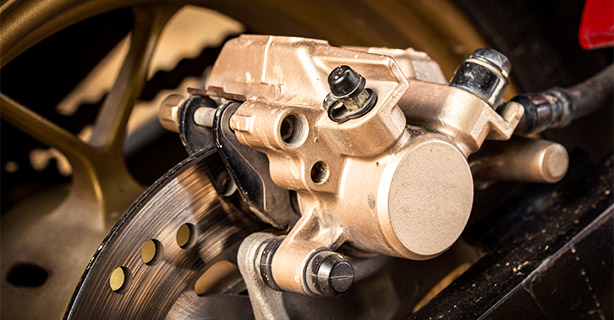Safe motorcycle rides start—and stop—with proper brake maintenance
0 min. read
When riders compare the specs of one motorcycle against another, a great deal of attention is paid to horsepower, torque, the time to go 0–60 mph, and top speed. Many riders turn to aftermarket engine performance upgrades and dyno tuning for maximum power. You need a balanced amount of stopping power to reign in all that get-up-and-go for a motorcycle to be truly roadworthy. That’s where your brakes come in.
Stopping safely
When confronted with a hazard that requires emergency braking, we need our brakes to help us stop in the shortest distance possible. Achieving the shortest stopping distance requires a combination of alertness (reaction time), skill at braking, and brake performance.
Of course, being alert and aware of the situations around us should be the only way we ride. We should regularly practice the skill of using maximum stopping power to know how to control it. So, is brake maintenance something you actively think about?
Brake maintenance
Maintaining your brakes is actually pretty easy. It starts with an inspection. The Motorcycle Safety Foundation T-CLOCS pre-ride inspection calls for checking that each brake keeps the motorcycle from rolling.
The majority of modern motorcycles have hydraulically operated disc brakes front and rear, so we’ll look at them first.
Disc brakes
With disc brakes, the pads are visible and can be checked for wear. Consult your owner’s manual, service manual, or mechanic for wear limits. Do-it-yourself servicing of disc brakes is possible with simple tools—if you’re mechanically inclined. Here are the things to check on disc brakes:
Brake fluid level
Brake fluid color—it darkens with age and signals the need for replacement
Brake lines and fittings for cracks or leaks
Pad wear to avoid damaging the disc brake rotor when they become thin
Brake rotor for signs of scoring, glazing, discoloration, warping, or oil contamination
Drum brakes
Drum brakes are a different story. Seeing the wear on brake shoes and drum surface requires removing the wheel—which is more than the average rider normally does. Hydraulic drum brakes generally self-adjust during normal wear, mechanically operated drum brakes are user adjustable. In either case, drum brakes should be inspected or serviced at every tire replacement. Sooner, if performance degrades.
Whether you do your own brake servicing or take it to a shop, make maintaining your brakes a regular part of your life as a motorcycle rider.
Till next time, ride safe!
We feel strongly about your safety and promote it through our Rider Training Course discount. Check it out.
Make sure you have the motorcycle coverages you need.
The general information in this blog is for informational or entertainment purposes only. View our blog disclaimer.
*Data accuracy is subject to this article's publication date.







